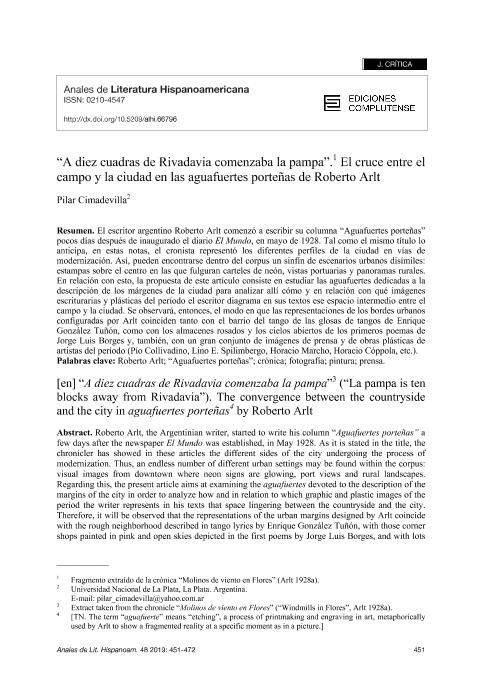Mostrar el registro sencillo del ítem
dc.contributor.author
Cimadevilla, Pilar María

dc.date.available
2022-10-28T16:06:31Z
dc.date.issued
2019-12
dc.identifier.citation
Cimadevilla, Pilar María; “A diez cuadras de Rivadavia comenzaba la pampa”: El cruce entre el campo y la ciudad en las aguafuertes porteñas de Roberto Arlt; Universidad Complutense de Madrid; Anales de la Literatura Hispanoamericana; 48; 12-2019; 1-22
dc.identifier.issn
0210-4547
dc.identifier.uri
http://hdl.handle.net/11336/175390
dc.description.abstract
El escritor argentino Roberto Arlt comenzó a escribir su columna Aguafuertes porteñas pocos días después de inaugurado el diario El Mundo, en mayo de 1928. Tal como el mismo título lo anticipa, en estas notas, el cronista representó los diferentes perfiles de la ciudad en vías de modernización. Así, pueden encontrarse dentro del corpus un sinfín de escenarios urbanos disímiles: estampas sobre el centro en las que fulguran carteles de neón, vistas portuarias y panoramas rurales. En relación con esto, la propuesta de este artículo consiste en estudiar las aguafuertes dedicadas a la descripción de los márgenes de la ciudad para analizar allí cómo y en relación con qué imágenes escriturarias y plásticas del período el escritor diagrama en sus textos ese espacio intermedio entre el campo y la ciudad. Se observará, entonces, el modo en que las representaciones de los bordes urbanos configuradas por Arlt coinciden tanto con el barrio del tango de las glosas de tangos de Enrique González Tuñón, como con los almacenes rosados y los cielos abiertos de los primeros poemas de Jorge Luis Borges y, también, con un gran conjunto de imágenes de prensa y de obras plásticas de artistas del período (Pío Collivadino, Lino E. Spilimbergo, Horacio Marcho, Horacio Cóppola, etc.).
dc.description.abstract
Roberto Arlt, the Argentinian writer, started to write his column “Aguafuertes porteñas” a few days after the newspaper El Mundo was established, in May 1928. As it is stated in the title, the chronicler has showed in these articles the different sides of the city undergoing the process of modernization. Thus, an endless number of different urban settings may be found within the corpus: visual images from downtown where neon signs are glowing, port views and rural landscapes. Regarding this, the present article aims at examining the aguafuertes devoted to the description of the margins of the city in order to analyze how and in relation to which graphic and plastic images of the period the writer represents in his texts that space lingering between the countryside and the city. Therefore, it will be observed that the representations of the urban margins designed by Arlt coincide with the rough neighborhood described in tango lyrics by Enrique González Tuñón, with those corner shops painted in pink and open skies depicted in the first poems by Jorge Luis Borges, and with lots f press images and artwork by artists during the same period (Pío Collivadino, Lino E. Spilimbergo, Horacio Marcho, Horacio Cóppola, among others.).
dc.format
application/pdf
dc.language.iso
spa
dc.publisher
Universidad Complutense de Madrid

dc.rights
info:eu-repo/semantics/openAccess
dc.rights.uri
https://creativecommons.org/licenses/by/2.5/ar/
dc.subject
ROBERTO ARLT
dc.subject
AGUAFUERTES PORTEÑAS
dc.subject
CRONICA
dc.subject
FOTOGRAFIA
dc.subject.classification
Literaturas Específicas

dc.subject.classification
Lengua y Literatura

dc.subject.classification
HUMANIDADES

dc.title
“A diez cuadras de Rivadavia comenzaba la pampa”: El cruce entre el campo y la ciudad en las aguafuertes porteñas de Roberto Arlt
dc.title
“La pampa is ten blocks away from Rivadavia”: The convergence between the countryside and the city in aguafuertes porteñas by Roberto Arlt
dc.type
info:eu-repo/semantics/article
dc.type
info:ar-repo/semantics/artículo
dc.type
info:eu-repo/semantics/publishedVersion
dc.date.updated
2022-10-28T14:49:27Z
dc.journal.volume
48
dc.journal.pagination
1-22
dc.journal.pais
España

dc.journal.ciudad
Madrid
dc.description.fil
Fil: Cimadevilla, Pilar María. Universidad Nacional de La Plata; Argentina. Consejo Nacional de Investigaciones Científicas y Técnicas; Argentina
dc.journal.title
Anales de la Literatura Hispanoamericana
dc.relation.alternativeid
info:eu-repo/semantics/altIdentifier/url/https://revistas.ucm.es/index.php/ALHI/article/view/66796
Archivos asociados
